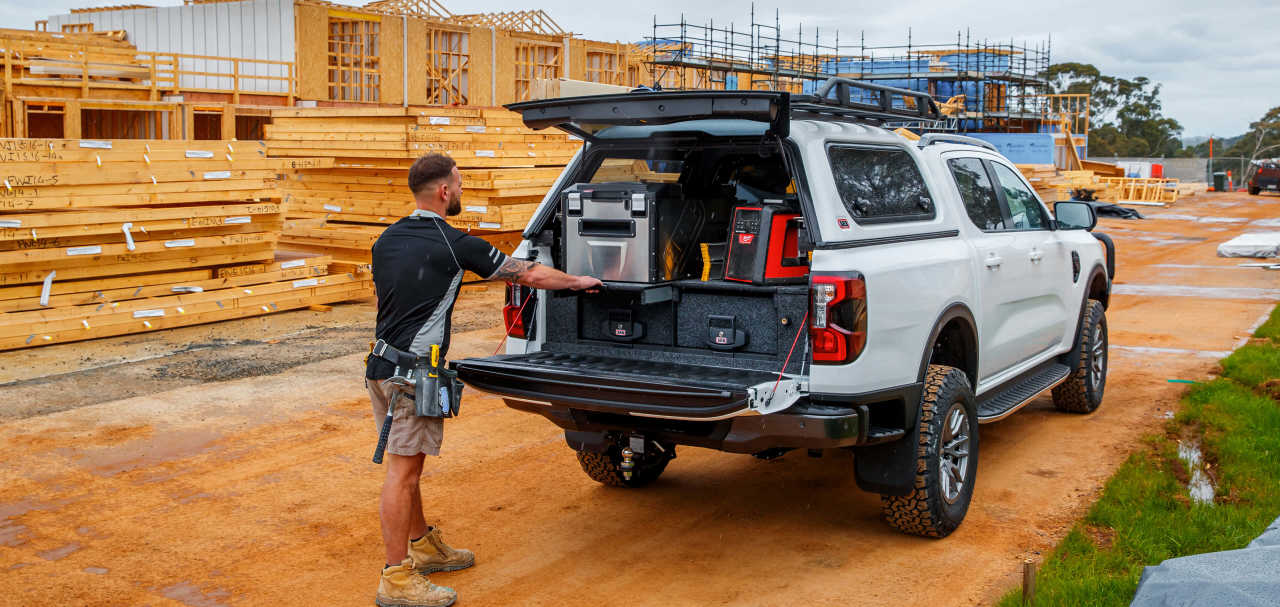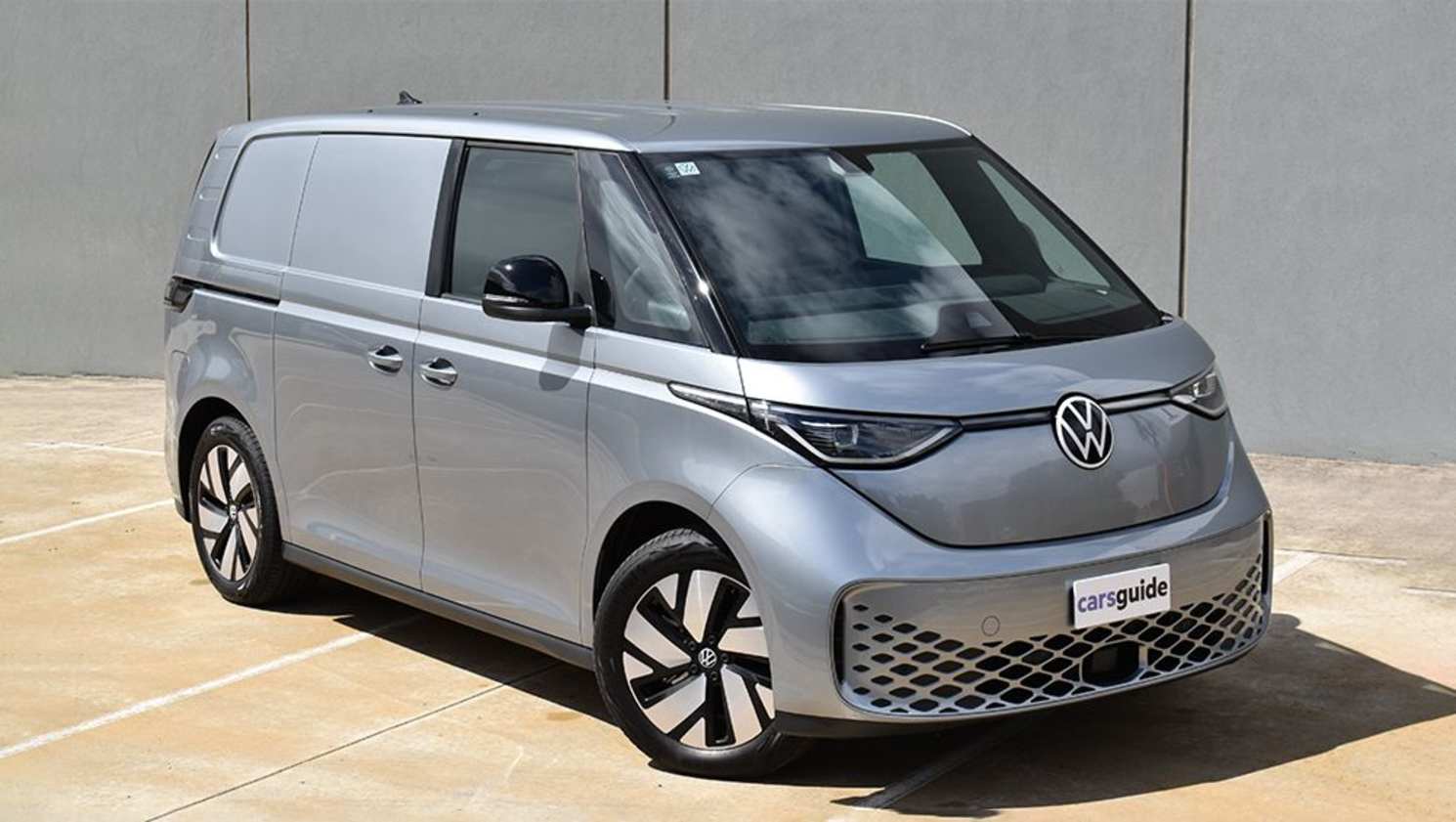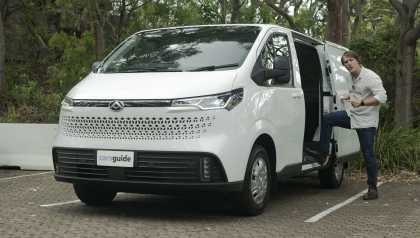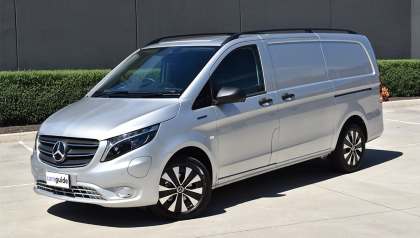Volkswagen’s ID.Buzz not only draws nostalgic styling inspiration from the iconic ‘Kombi’ van of the 1950s and ‘60s. Like the original, it also has its engine located at the back driving the rear wheels, which optimises traction and minimises drivetrain noise for the driver.
However, that’s where the similarities end because VW’s reincarnation of its classic commercial van/minibus – the ‘Kombinationskraftwagen’ (combination motor vehicle) or ‘Kombi’ for short - is a thoroughly modern design that embraces fully electric power.
This silent, smooth and efficient drivetrain produces zero emissions and astonishing performance for a van, combined with chassis dynamics and safety that designers of its perpetually underpowered ancestor could never have believed possible.
Like the original, the ID. Buzz range offers both multi-seat ‘lifestyle’ and panel van ‘workhorse’ variants. So, given our tradie focus, we spent a week in the work-focused Cargo model to see how it measures up in the popular mid-sized (2.5 to 3.5-tonne GVM) commercial van segment.
Does it represent good value for the price? What features does it come with? 8/10
8 / 10
Our test vehicle comes in one specification, with a single electric motor and a single-speed transmission, for a list price of $79,990 plus on-road costs. Yep, almost $80K, but that looks like a bargain when compared to the full-electric Mercedes-Benz eVito van at $98,951.

Our example is fitted with numerous options including Mono Silver Metallic paint ($1890), IQ. Light LED matrix headlights ($2100), illuminated moulding ($490), electric open/close side-doors ($890) and 19-inch ‘Tilburg’ alloy wheels ($3500). These goodies add $8870 to the price, so not much change from $90K - and that’s all before on-roads.

The ID.Buzz Cargo comes standard with 18-inch steel wheels fitted with 235/60R18 front tyres, wider 255/55R18 rears and full wheel-covers. However, given their different sizes and the full-electric drivetrain, there’s no full-size spare included, so owners must rely on a ‘tyre mobility set’ comprising tyre sealant and a 12-volt air compressor.
There’s also body-coloured bumpers, full LED lighting including daytime running lights, heated front door mirrors, a power tailgate and more.

The cabin has seating for up to three occupants across a fabric-trimmed driver’s bucket seat and two-passenger bench seat, plus there’s a sealed bulkhead (with large window) to separate the cabin and cargo bay.
It includes four USB-C ports and a 12-volt socket, dual-zone climate control, 10-colour ambient lighting, a synthetic leather-rimmed wheel with multifunction controls, a driver’s instrument cluster mounted on the steering column (so it moves with height/reach adjustments), and a multimedia system controlled by a 10-inch colour touchscreen with Apple/Android connectivity, DAB+ digital radio and more.

Cables for domestic and public charging are included, and Volkswagen offers numerous options in addition to those fitted to ours, including rear barn doors in preference to the standard swing-up tailgate.
Is there anything interesting about its design? 9/10
9 / 10
The Cargo rides on a 2989mm wheelbase, which is the shortest of two wheelbases offered in the three-model ID. Buzz range. It measures 4712mm in overall length, 1985mm in width and up to 1953mm in height (depending on tyre size), so it can comfortably access height-restricted areas like multi-storey carparks and underground loading zones.
It’s built on Volkswagen’s dedicated fully electric MEB chassis platform, with the electric motor positioned between the rear wheels to optimise traction and its large battery mounted beneath the load-floor to maximise cargo bay volume. MacPherson strut front/semi-trailing arm rear suspension ensures a smooth ride and four-wheel disc brakes provide ample stopping power.

The MEB platform also ensures a spacious cabin, short front/rear overhangs and a usefully tight 11.09-metres turning circle for easy maneuvering and parking in tight city and suburban use.
Styling is clearly inspired by the original split-window Kombi, particularly the prominent VW badge displayed on the nose and optional nostalgic two-tone paint schemes (not available on Cargo).
Even so, paying homage to its iconic ancestor does not detract from the ID.Buzz’s handsome and futuristic styling, particularly on the Cargo’s short wheelbase. Combined with the optional 19-inch alloys on our test vehicle, it has a chunky and muscular stance.

The spacious cabin design shows typical Volkswagen commercial vehicle minimalism, with a wipe-clean rubber floor, fabric-trimmed seating and predominantly grey surfaces with contrasting taupe headlining, door and dash inserts. There’s also the usual satin chrome and piano black highlights.
Our only gripe is that the central touchscreen controls not only multimedia but also often-used vehicle settings (like climate control), which can be fiddly and distracting when driving. The impending return of physical buttons and dials to VW dash designs will be celebrated.

How practical is its space and tech inside? 8/10
8 / 10
With its 2376kg kerb weight and 3150kg GVM, our test vehicle has a 774kg payload rating that is modest compared to numerous turbo-diesel mid-sized van rivals with one-tonne-plus ratings. Up to 100kg can be carried on the roof.
It’s also rated to tow up to 1200kg of braked trailer, which is also relatively small compared to some turbo-diesel rivals that legally can tow up to 2500kg. Volkswagen does not publish a GCM (Gross Combination Mass) rating, so we can’t confirm how much weight it can legally carry and tow at the same time.

The cargo bay, which has a relatively small 3.9 cubic metres of load volume, is accessed through sliding doors on each side and a swing-up tailgate. Its rubber-coated wooden floor is 2208mm long (with an extra 450mm available using the small load-through hatch at the base of the cabin bulkhead) and 1732mm wide, with 1230mm between the rear-wheel housings.
Therefore, it can carry one standard 1165mm-square Aussie pallet or two Euro pallets, held in place by six load-anchorage points in the floor. There’s also load-anchorage hooks at the front and rear of the rear-wheel housings.
Given its 1257mm load height, adjustable tie-down rails are mounted on the walls and across the cabin bulkhead at mid-height for extra support of tall loads. The walls and doors are lined from floor to roof and there’s also bright LED lighting, a first-aid kit and 12-volt socket.

A welcome feature is under-floor storage in the cargo bay, with removal of a cover plate on the driver’s side giving access to a cavity that provides convenient and secure storage of the vehicle’s charging cables.
With seating for up to three occupants, the least-favoured central position is accommodating for most heights, given I’m 186cm and have adequate headroom, knee clearance from the dash and foot-room thanks to a predominantly flat floor.

Even so, the passenger bench seat offers no adjustment and hip/shoulder-room for three large people would test friendships over long distances, so best to restrict three-ups to short trips only.
Cabin storage includes a big bottle-holder and bin in the base of each front door, with a smaller shelf at mid-height. Storage has been optimised in the top of the dash, which extends a long way forward to the base of the windscreen, by incorporating multiple open bins and two small-bottle/cupholders.
There’s also a large open shelf and glovebox on the passenger side, but no overhead glasses-holder and no under-seat storage for the bench seat.
What are the key stats for its motor? 9/10
9 / 10
A single electric motor drives the rear wheels through a single-speed transmission. It can produce up to 210kW of power and 550Nm of torque, and there are four selectable drive modes comprising Comfort (default), Eco, Sport and Individual.
What is its driving range? What is its charging time? 9/10
9 / 10
Volkswagen claims an official driving range of 431km (WLTP) and average energy consumption of 20.3kWh/100km from its 79kWh lithium-ion battery.
We covered 249km of city, suburban and highway driving, which included switching between the different drive modes and 50km carrying its maximum payload.
At the completion of our test week, during which no cable-charging took place, the instrument display was still showing 40 per cent of charge and 180km of driving range remaining.

It also showed average consumption was 17.8kWh/100km, which was significantly lower than the official figure and confirmation that its impressive claimed real-world driving range of more than 400km is credible. And that's more than ample daily range for most tradie/delivery vans in urban use.
Volkswagen claims 185kW DC fast-charging from 10 to 80 per cent battery charge in 26 minutes. With an 11kW AC wall-box, 0 to 100 per cent takes 7 hrs 30 mins, while a domestic AC wall socket takes 22 hrs 45 mins.
What’s it like to drive? 9/10
9 / 10
The large cabin doors open wide for easy access and it has an upright but comfortable driving position, even though there’s no adjustment of lumbar support or base cushion rake. The thick-rimmed faux-leather steering wheel feels nice in your hands and there’s a big left footrest to brace against.
Although the windscreen is positioned a long way ahead of the driver, there’s large windows between the A and B pillars on each side to ensure clear vision from all angles. There’s also good eyelines to all mirrors, but the central mirror’s view through the tailgate window is partly blocked by the centre seat headrest.
The electric drivetrain creates a near-silent driving experience with most noise coming from the tyres, which along with wind noise is hardly intrusive even at highway speeds.
Overall, the smoothness and noise suppression are outstanding for a commercial vehicle, creating a calm working environment in which you feel insulated from the outside world. The large blind-spot over the driver’s left shoulder is largely alleviated by the active blind-spot monitoring.

A stalk on the steering column allows selection of Park, Drive, Neutral and Reverse plus a maximum setting for regenerative braking (B).
We also experimented with the different drive modes comprising Comfort, Eco, Sport and Individual, although most of our test was conducted in the default ‘Comfort’ mode, which provides an ideal balance of performance and energy use.
Acceleration from standing starts is effortless and rapid, given its instant and abundant torque delivery. It’s a smooth and unrelenting surge that presses you firmly into the seat, as the digital speedo shows that triple-digit speeds are fast approaching.
Selecting ‘Sport’ raises performance to a level most would not believe possible in a commercial van - or would realistically ever need. ‘Eco’ does the opposite to minimise energy use, but is still more than adequate in response for most driving. ‘Individual’ allows personalisation of vehicle settings.
It also has superb steering feel with its electro-mechanical assistance and the four-coil suspension delivers brilliant chassis dynamics that are more akin to those of a performance sedan than a commercial van.

Also outstanding is its efficiency in recovering energy through regenerative braking to maintain healthy battery charge, particularly given the performance it delivers. On numerous occasions we finished drives with the displayed driving range either the same, or in some cases higher, than when we started. As a result, range anxiety is greatly reduced.
To test its GVM rating we forklifted 650kg into the cargo bay, which with driver equalled a payload that was only about 20kg under its legal limit.
The rear suspension compressed less than 30mm under this weight and glided over bumps on our 50km city/suburban test route without a hint of bottoming-out.
The electric motor, with its ample 550Nm of torque, was not fazed either and maintained its lively acceleration even on steep climbs. Fact is, this payload didn’t feel like it was even there, although that's not to say that energy use would not noticeably increase if driven longer distances.
What safety equipment is fitted? What safety rating? 8/10
8 / 10
There’s no rating from ANCAP, but its Euro NCAP affiliate awarded the ID.Buzz range a full five-star rating when tested in 2022.
Standard safety menu includes front/side/curtain airbags, AEB with pedestrian and cyclist monitoring, adaptive cruise control with auto stop-and-go for heavy traffic situations, blind-spot monitoring, lane-keeping, front/rear parking sensors, reversing camera, tyre pressure monitoring and lots more.
What warranty is offered? What are its service intervals? What are its running costs? 8/10
8 / 10
It comes standard with a five years/unlimited-km warranty, plus eight years/160,000km battery warranty and two years roadside assist.
Scheduled servicing every two years/30,000km whichever occurs first. Capped-price of $670 applies to each of the first five scheduled services up to 10 years/150,000km, or a total of $3350. Volkswagen also offers various service plans.
Verdict
The ID.Buzz Cargo is a reimagining of the humble mid-sized commercial van, as it combines European chic and zero emissions with astonishing performance. But it could fall short for tradies and other pragmatic business owners who prioritise payload, load volume, tow ratings, purchase price - even a spare tyre. However, for cashed-up buyers who share Volkswagen’s bold vision, it has no equal.







.jpg)






.jpg)


.jpg)